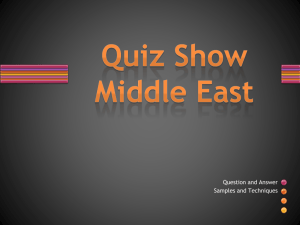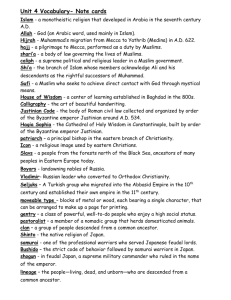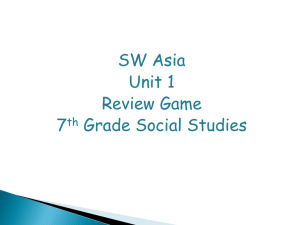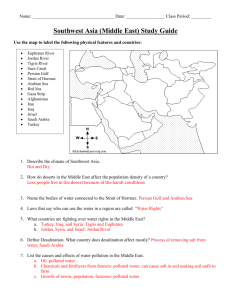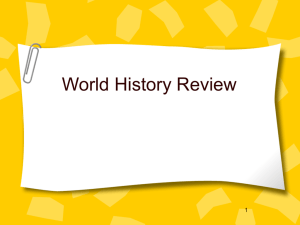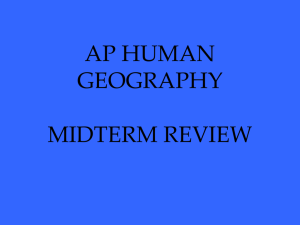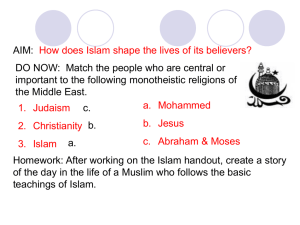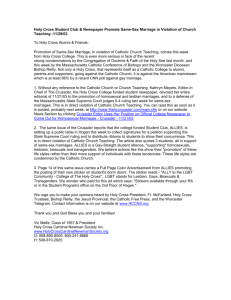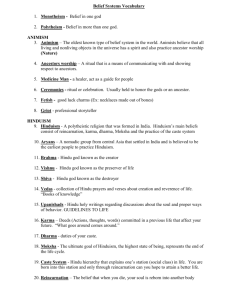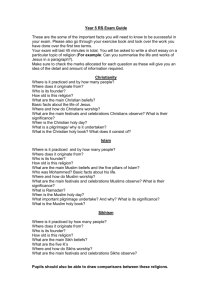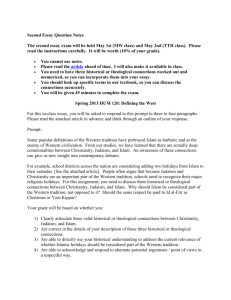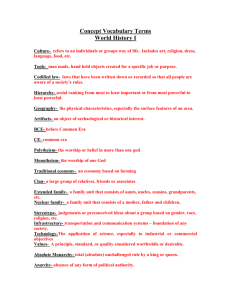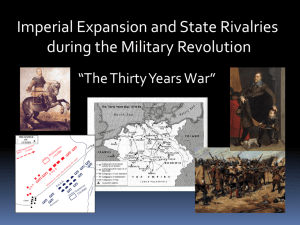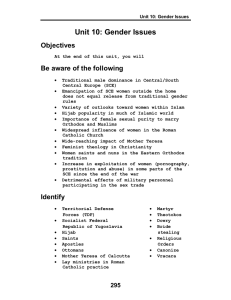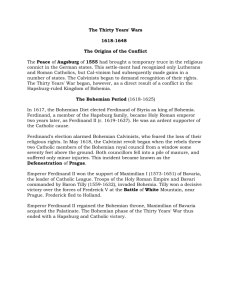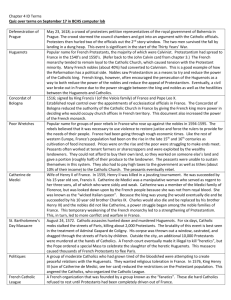Grade 7
advertisement
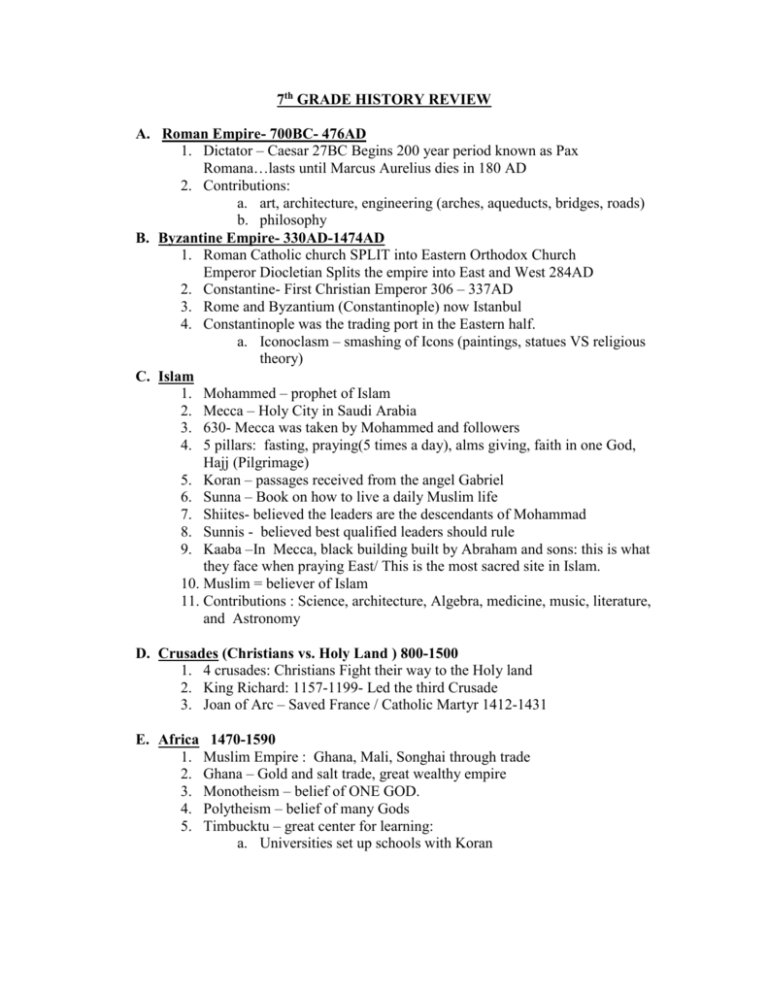
7th GRADE HISTORY REVIEW A. Roman Empire- 700BC- 476AD 1. Dictator – Caesar 27BC Begins 200 year period known as Pax Romana…lasts until Marcus Aurelius dies in 180 AD 2. Contributions: a. art, architecture, engineering (arches, aqueducts, bridges, roads) b. philosophy B. Byzantine Empire- 330AD-1474AD 1. Roman Catholic church SPLIT into Eastern Orthodox Church Emperor Diocletian Splits the empire into East and West 284AD 2. Constantine- First Christian Emperor 306 – 337AD 3. Rome and Byzantium (Constantinople) now Istanbul 4. Constantinople was the trading port in the Eastern half. a. Iconoclasm – smashing of Icons (paintings, statues VS religious theory) C. Islam 1. Mohammed – prophet of Islam 2. Mecca – Holy City in Saudi Arabia 3. 630- Mecca was taken by Mohammed and followers 4. 5 pillars: fasting, praying(5 times a day), alms giving, faith in one God, Hajj (Pilgrimage) 5. Koran – passages received from the angel Gabriel 6. Sunna – Book on how to live a daily Muslim life 7. Shiites- believed the leaders are the descendants of Mohammad 8. Sunnis - believed best qualified leaders should rule 9. Kaaba –In Mecca, black building built by Abraham and sons: this is what they face when praying East/ This is the most sacred site in Islam. 10. Muslim = believer of Islam 11. Contributions : Science, architecture, Algebra, medicine, music, literature, and Astronomy D. Crusades (Christians vs. Holy Land ) 800-1500 1. 4 crusades: Christians Fight their way to the Holy land 2. King Richard: 1157-1199- Led the third Crusade 3. Joan of Arc – Saved France / Catholic Martyr 1412-1431 E. Africa 1470-1590 1. Muslim Empire : Ghana, Mali, Songhai through trade 2. Ghana – Gold and salt trade, great wealthy empire 3. Monotheism – belief of ONE GOD. 4. Polytheism – belief of many Gods 5. Timbucktu – great center for learning: a. Universities set up schools with Koran F. Middle Ages 476-1400 1. Growth of Catholic Church to power- largest landholder, very wealthy 2. Feudalism- hierarchy that grew out of need for protection- based on loyalty- code of chivalry (knights) – social structure 3. Charlemagne- Holy Roman Emperor 800AD 4. William the Conqueror: French King overtakes England 1066-Hastings 5. Architecture= Stain Glass, Dome 6. Excommunication was being kicked out of church 7. Universities sprang out of monasteries 8. Black Death- wiped out 1/2 of Europe 9. Decline of Feudalism : Attributed to 3 things: a. Signing the Great Charter – Magna Carta (gave people their own rights and limited the king’s power) 1215 b. Black Death Plague (1347) c. 100 years war between France and England (shifted power from feudal lords to monarchy and common people) 10. Model of Parliament= King Edward I gave voice to the People(foundation of today’s Constitutional Triangle 11. Joan of Arc- 100 years war(1337-1453) – inspired France to defeat Britain. G. Aztecs(1195-1521), Incas(1200-1532), Mayas300BC-950AD)(Mexico) (South America)(Central America) 1. Contributions- Math, Architecture, hieroglyphic writing 2. Social Pyramid- class structure a. ruler b. nobles, priests c. merchants, artisans d. peasants e. slaves Aztecs- Mexico (conquered by Cortez) Floating gardens Sacrifices Incas – Peru Class structure Mayas- Central America Achievements: suspension bridges, roads ,engineered floating islands Science, Technology, Astronomy, Arts, Architecture, Mathematics Glyphs – language and writing Calendar (365 days). Sacrifices H. Japan- 500-1600 Prince Shotoku:- First Japanese ruler to borrow ideas about government from China 1. Isolated Country 2. Feudal System- Emperor, shogun, Daimyo, Samarai 3. Bushido - code of honor 4. Buddhism- started in India- by way of China took over Shinto 5. Art, Literature, Architecture, Noh theatre, Noh dramas 6. Dynasties 7. Murasaki- wrote tale of Ghangi ( only work of literature written about life in court from a woman’s viewpoint. I. Renaissance- “ Rebirth “ Where? - Italy (art, learning, Greek philosophers) Humanism- Focused on life on earth - Value human beings Florence City- growth of city- states- trading, Classical art Art changed- perspective, drawings, changed away from religious art, 3-D, more Colorful Leonardo Da Vinci (Renaissance man) Last Supper, Mona Lisa Sculptures, Engineering, Science, Anatomy, Moses, Michaelangelo painter –Sistine Chapel (The Creation) David (famous statue) Scientific Method – Francis Bacon and Renee Descartes Hypothesis Galileo – revolution of earth around sun ( Copernicus), first telescope Dante – Renaissance writer (Heaven and Hell) Queen Elizabeth – most successful and popular monarch (English Golden Age) 40 years of her reign, Funded lots of North American Exploration. Shakespeare - playwright, Comedy vs. Tragedy Cervantes - writer of Don Quixote J. Reformation = Reform Split of Catholicism and Protestantism = Protestants breaking away from Catholic Church. 1. 2. 3. 4. 5. Gutenberg - printing press - printed Bible 1450s Tindale - Translated Bible to English in early 1500s Martin Luther- early 1500s, 95 thesis nailed to church, started own church Calvin = humanist (salvation) King Henry VIII - started Anglican Church so he could get divorced. K. Age of Exploration Explorers - motives Map making - Ptolemy L. Scientific Revolution Heliocentric - Sun center of universe and earth rotates around it. Rationalism - belief of reasoning and logic - Greek thinkers Galileo - telescope Newton - gravity Inventions microscope, barometer, thermometer M. Enlightenment General trust in reason Extension of Scientific Revolution John Locke - Natural Rights Bill of Rights

